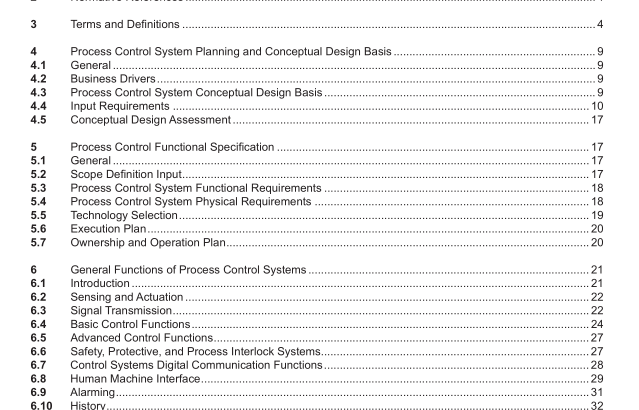API 554:2021 pdf free download.Process Control Systems— Functions and Functional Specifcation Development
4.4.3.2.8 What types of remote operations will be required vs local monitoring and operator actions? Are there remote facilities to be controlled by this control system? If so, what are the design parameters for such remote control, including security?
4.4.3.2.9 How are alarms communicated to the operator? What are all the sources of hard and soft alarms? What provisions are required for alarm management, screening, and analysis? Is a separate alarm system required? 4.4.3.2.10 How are process alerts to be managed?
Is there a single site-wide alert system that requires preregistration of all alerts with automated escalation to minimize the places a person needs to look for alerts, whether process or equipment health?
4.4.3.2.11 How is the process operator to enter and monitor the status of work orders? How is the process operator to respond to system maintenance alarms?
4.4.3.2.12 Will a process operator training system be installed? What fdelity will be required for the process model? Will the model be required to run faster than real time? Will the training system be required to upload the current operating system confguration and status or a snapshot of the unit operation as a starting condition? If the training system is to be identical to the operating system, how will the two be isolated such that training actions do not afect current operations? Is the training system to be used for engineering analysis and design “what-ifs”?
4.4.3.3 Physical Issues
4.4.3.3.1 Where are HMIs going to be located? Is there a central control room? Where is it relative to the plant? Will the building that houses the HMI serve as or be considered an emergency gathering area? Will any of the HMIs be located in electrically classifed areas, and if so, what classifcations shall be met?
4.4.3.3.2 How many and what type of HMI stations are required? Are remote interface stations required? Are there any special operator interface requirements such as portable interfaces, handheld view and data entry functions, etc.?
4.4.3.3.3 What space requirements are required to accommodate workstations needed for access to business functions such as e-mail and word processing (not connected to the PCN)?
4.4.3.3.4 Will lifecycle requirements for the installation require provisions for expansion or upgrade over its life; is this a complex wide system or single plant/unit? What is the required service life?
4.4.3.3.5 What provisions need to be made for expansion? Is spare capacity or room to expand required?
4.4.3.3.6 Are there specifc drawing standards for process graphics, such as: specifc symbol usage and interpretation, line weights, line color codes, overall graphics layout, density, etc.?
4.4.3.3.7 Are third-party vendors permitted to access data from specifc devices, such as turbines and compressors to provide monitoring and diagnostic assistance? If so, what are the specifc security and other procedures?
4.4.3.4 Interface Issues
4.4.3.4.1 What functions associated with plant security will operators be responsible for monitoring—should the operators’ console incorporate video capability?
4.4.3.4.2 Are special purpose operator interfaces required for specialty control systems such as compressor or turbine controls, stand-alone PLC, analyzers, etc.? If so, where are these located? What information shall be displayed on the HMIs? How are the systems connected to the HMIs? What are the security provisions required?
4.4.3.4.3 What interfaces are required to other specialty systems that may have local PLC or other types ofcontrols? What information shall be displayed at the HMIs? What are the security provisions?
4.4.3.4.4 What level of redundancy, security, availability, and reliability is required? Are process shutdowns dueto control system failure acceptable or shall the design be robust enough to tolerate failures? What provisionsare required to allow manual operation or override of automatic operation?
4.4.3.4.5 ls there a need to consider demands upon the control system for functions that may not be typicallyconsidered by design engineers? Examples are environmental reporting, alarm filtering, sequence of events,computations, etc.
4.4.3.4.6 What communications requirements exist? Do operators have radios or other communications withcontrol centers?
4.4.3.4.7 Are there requirements for video monitoring of flares, process areas, or other video applications? Arethese to be incorporated into the Pcs?
4.3.3.4.8 How does the operator interface with laboratory systems? How are samples labeled and how doesthe operator obtain laboratory results?
4.4.3.4.9 Are online documentation and help systems to be available within the PCS or only from the businessLAN? Wwill the process operator have the ability to make entries into the help system for future reference.API 554: pdf download.API 554:2021 pdf free download
